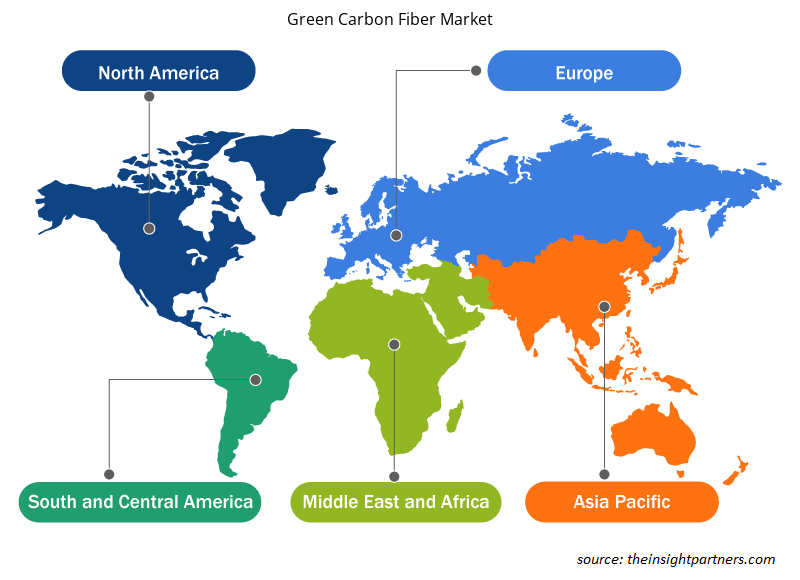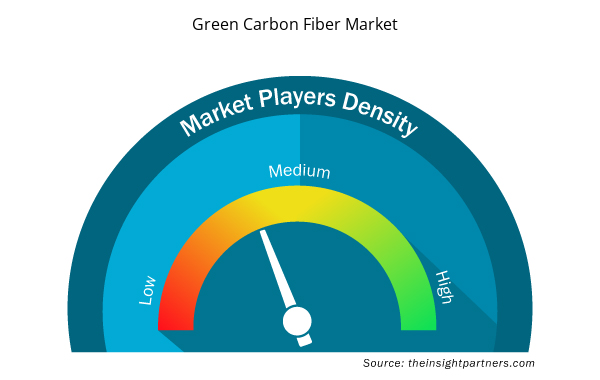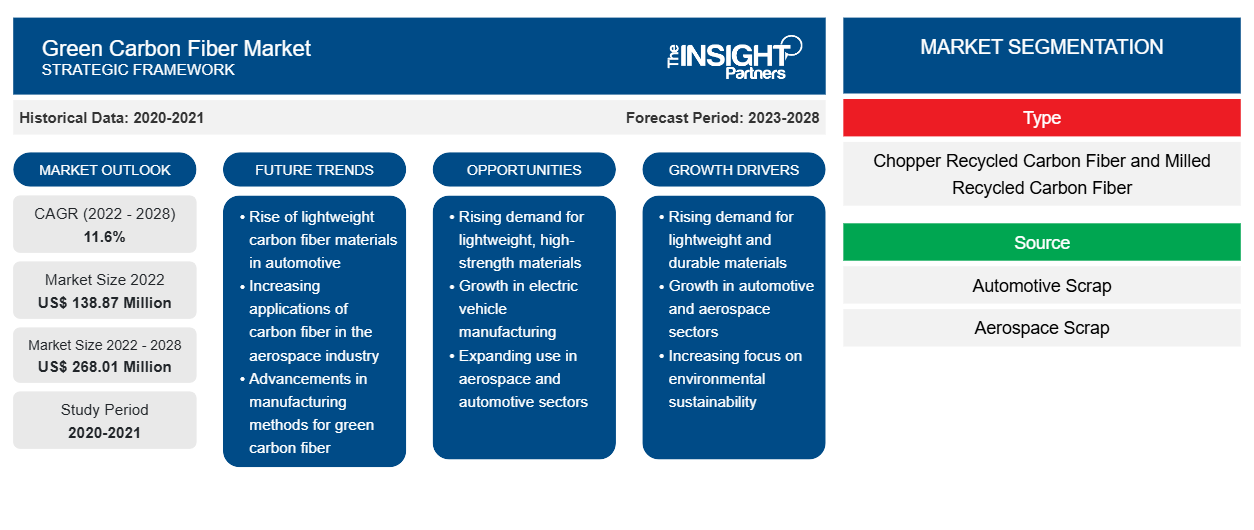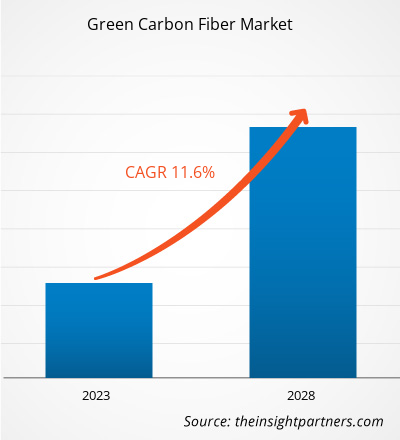[Rapporto di ricerca] Il mercato della fibra di carbonio verde è stato valutato a 138,87 milioni di dollari nel 2022 e si prevede che raggiungerà i 268,01 milioni di dollari entro il 2028; si prevede che registrerà un CAGR dell'11,6% dal 2022 al 2028.
La fibra di carbonio verde è una fibra di carbonio riciclata. Il riciclaggio della fibra di carbonio è un recupero di fibre da compositi rinforzati con fibra di carbonio (CFRC). Esistono due tipi di rifiuti di fibra di carbonio. Il primo tipo di rifiuto è la fibra di carbonio vergine, scarti del prodotto generato dalla fibra secca e dal materiale scaduto non utilizzato, che sono anche chiamati scarti. La fibra di carbonio verde o riciclata viene utilizzata per produrre nuove parti ad alte prestazioni in vari settori di utilizzo finale. I vantaggi della fibra di carbonio verde, insieme alla crescente domanda di materiali economici e leggeri da vari settori di utilizzo finale come l'automotive, l'aerospaziale, l'energia eolica, gli articoli sportivi, ecc., stanno rafforzando la crescita del mercato delle fibre di carbonio verdi.
Nel 2022, l'Asia Pacifica ha detenuto la quota maggiore del mercato globale della fibra di carbonio verde e si stima che l'Europa registrerà il CAGR più elevato durante il periodo di previsione. Il mercato della fibra di carbonio verde dell'Asia Pacifica è segmentato in Cina, Giappone, India, Corea del Sud, Australia e resto dell'Asia Pacifica. L'industria aerospaziale e della difesa nell'Asia Pacifica è cresciuta in modo significativo negli ultimi anni. Nell'Asia Pacifica, la Cina è uno dei maggiori produttori di aeromobili e uno dei maggiori mercati per i passeggeri aerei nazionali.
Personalizza questo report in base alle tue esigenze
Riceverai la personalizzazione gratuita di qualsiasi report, comprese parti di questo report, o analisi a livello nazionale, pacchetto dati Excel, oltre a usufruire di grandi offerte e sconti per start-up e università
- Scopri le principali tendenze di mercato in questo rapporto.Questo campione GRATUITO includerà analisi di dati che spaziano dalle tendenze di mercato alle stime e alle previsioni.
Impatto della pandemia di COVID-19 sul mercato della fibra di carbonio verde
I paesi dell'Asia Pacifica, come Cina, India e Giappone, hanno dovuto affrontare sfide significative a causa della chiusura delle unità produttive, dell'interruzione delle catene di fornitura e della carenza di materie prime durante la pandemia di COVID-19; ciò ha provocato un enorme crollo nella produzione e distribuzione dei prodotti. Tuttavia, la pandemia ha anche portato alcune opportunità redditizie per i principali attori che operano nel mercato della fibra di carbonio verde nell'Asia Pacifica. Molte aziende nel mercato della fibra di carbonio verde hanno iniziato a implementare protocolli e norme governative per vendere i loro prodotti durante o dopo la seconda ondata di COVID-19 per cogliere questa opportunità e aumentare le vendite. Quindi, le approvazioni da parte dei governi tendono ad aumentare la domanda di fibre di carbonio sostenibili, aumentando la crescita del mercato della fibra di carbonio verde.
Approfondimenti di mercato
L'aumento dell'uso della fibra di carbonio verde nel settore dell'energia eolica stimola il mercato della fibra di carbonio verde
La domanda di turbine eoliche sta aumentando rapidamente poiché vari paesi in tutto il mondo stanno passando dai combustibili fossili non rinnovabili e dannosi per il clima a fonti di energia pulite e rinnovabili. Inoltre, l'aumento del prezzo dell'elettricità sta spingendo la necessità di fonti di energia rinnovabili. Il mercato dell'energia eolica sta crescendo poiché i governi di vari paesi come Stati Uniti, Germania, Arabia Saudita e Cina stanno prendendo iniziative per produrre energia rinnovabile. Un aumento della domanda di fonti di energia rinnovabile, in particolare energia eolica, e gli sforzi per ridurre la dipendenza dalla generazione di energia basata sui combustibili fossili sono fattori significativi per la crescita del segmento dell'energia eolica, alimentando infine la crescita del mercato della fibra di carbonio verde.
I polimeri rinforzati con fibre di carbonio vergini (VCF) vengono utilizzati per realizzare i cappucci delle pale delle turbine eoliche, mentre i polimeri con fibre di vetro vengono utilizzati per realizzare le pelli dei componenti delle pale. Tuttavia, la fibra di carbonio verde è ora ampiamente utilizzata nelle turbine eoliche, poiché le pale ibride in fibra di carbonio riciclata offrono prestazioni ambientali migliori del 12-89%. I tempi di ammortamento energetico e di carbonio per le pale ibride in fibra di carbonio riciclata sono stati inferiori del 5-13% rispetto a quelli degli operatori storici del mercato. L'utilizzo di fibre di carbonio riciclate per le parti delle pale delle turbine eoliche può essere fattibile dal punto di vista meccanico e offrire significativi vantaggi ambientali rispetto alle fibre di vetro. Queste proprietà caratteristiche della fibra di carbonio hanno contribuito a produrre turbine eoliche migliori e una maggiore produzione di energia. Pertanto, il crescente utilizzo di fibre di carbonio verdi nel settore dell'energia eolica sta stimolando la crescita del mercato.
Informazioni basate sul tipo
In base al tipo, il mercato della fibra di carbonio verde è diviso in fibra di carbonio riciclata chopper e fibra di carbonio riciclata macinata. Il segmento della fibra di carbonio riciclata macinata ha detenuto una quota maggiore del mercato nel 2022. La fibra di carbonio riciclata macinata è realizzata macinando la fibra tagliata in una polvere (macinata). La lunghezza usuale della fibra di carbonio riciclata macinata è di 80-100 micrometri. Queste fibre offrono dissipazione elettrostatica e resistenza.
Approfondimenti basati sulla fonte
In base alla fonte, il mercato della fibra di carbonio verde è segmentato in rottami automobilistici, rottami aerospaziali e altri. Si prevede che il segmento dei rottami automobilistici registrerà il CAGR più elevato durante il periodo di previsione. Le fibre di carbonio riciclate possono essere ottenute da circa il 40-60% del volume di rottami derivanti dalla produzione di plastica rinforzata con fibra di carbonio (CFRP) per uso automobilistico. L'utilizzo di fibre di carbonio riciclate può aiutare i produttori di automobili a ottenere più chilometri dal veicolo.
Approfondimenti basati sulle applicazioni
In base all'applicazione, il mercato della fibra di carbonio verde è segmentato in aerospaziale, automobilistico, energia eolica, articoli sportivi e altri. Il segmento automobilistico ha rappresentato la quota di mercato maggiore nel 2022. L'industria automobilistica utilizza frequentemente fibre di carbonio riciclate per realizzare pannelli del telaio, pavimenti, pannelli del tetto, vani ruota di scorta e interni del bagagliaio o del cofano.
L'azienda utilizza un processo a ciclo chiuso per il riciclaggio delle fibre di carbonio secche. Il costo di produzione delle automobili che utilizzano fibre di carbonio riciclate è relativamente inferiore al costo di produzione dell'acciaio. Inoltre, le fibre di carbonio riciclate possono essere modellate e modellate in forme diverse, il che non avviene con l'acciaio. Queste proprietà delle fibre di carbonio riciclate stanno rafforzando la loro domanda nel settore automobilistico.
I principali attori che operano nel mercato della fibra di carbonio verde includono Procotex Corp SA, Vartega Inc, Sigmatex (UK) Ltd, Shocker Composites LLC, Carbon Conversions Co, SGL Carbon SE, Toray Industries Inc, Gen 2 Carbon Ltd, Catack-H Co Ltd e Innovative Recycling. Queste aziende si stanno concentrando sul lancio di nuovi prodotti e sulle espansioni geografiche per soddisfare la crescente domanda dei consumatori in tutto il mondo. Hanno una presenza globale diffusa, che consente loro di servire un ampio gruppo di clienti e di conseguenza aumenta la loro quota di mercato. Questi attori di mercato si concentrano fortemente sul lancio di nuovi prodotti e sulle espansioni regionali per aumentare la loro gamma di prodotti nei portafogli specializzati.
Approfondimenti regionali sul mercato della fibra di carbonio verde
Le tendenze regionali e i fattori che influenzano il Green Carbon Fiber Market durante il periodo di previsione sono stati ampiamente spiegati dagli analisti di Insight Partners. Questa sezione discute anche i segmenti e la geografia del Green Carbon Fiber Market in Nord America, Europa, Asia Pacifico, Medio Oriente e Africa e Sud e Centro America.

- Ottieni i dati specifici regionali per il mercato della fibra di carbonio verde
Ambito del rapporto sul mercato della fibra di carbonio verde
| Attributo del report | Dettagli |
|---|---|
| Dimensioni del mercato nel 2022 | 138,87 milioni di dollari USA |
| Dimensioni del mercato entro il 2028 | 268,01 milioni di dollari USA |
| CAGR globale (2022 - 2028) | 11,6% |
| Dati storici | 2020-2021 |
| Periodo di previsione | 2023-2028 |
| Segmenti coperti | Per tipo
|
| Regioni e Paesi coperti | America del Nord
|
| Leader di mercato e profili aziendali chiave |
|
Densità degli attori del mercato della fibra di carbonio verde: comprendere il suo impatto sulle dinamiche aziendali
Il mercato del Green Carbon Fiber Market sta crescendo rapidamente, spinto dalla crescente domanda degli utenti finali dovuta a fattori quali l'evoluzione delle preferenze dei consumatori, i progressi tecnologici e una maggiore consapevolezza dei benefici del prodotto. Con l'aumento della domanda, le aziende stanno ampliando le loro offerte, innovando per soddisfare le esigenze dei consumatori e capitalizzando sulle tendenze emergenti, il che alimenta ulteriormente la crescita del mercato.
La densità degli operatori di mercato si riferisce alla distribuzione di aziende o società che operano in un particolare mercato o settore. Indica quanti concorrenti (operatori di mercato) sono presenti in un dato spazio di mercato in relazione alle sue dimensioni o al valore di mercato totale.
Le principali aziende che operano nel mercato della fibra di carbonio verde sono:
- Società Procotex SA
- Vartega Inc
- Sigmatex (Regno Unito) Ltd
- Compositi Shocker LLC
- Conversioni di carbonio Co
Disclaimer : le aziende elencate sopra non sono classificate secondo un ordine particolare.

- Ottieni una panoramica dei principali attori del mercato della fibra di carbonio verde
Segnala i riflettori
- Tendenze industriali progressive nel mercato della fibra di carbonio verde per aiutare le aziende a sviluppare strategie efficaci a lungo termine
- Strategie di crescita aziendale adottate dagli operatori del mercato nei paesi sviluppati e in via di sviluppo
- Analisi quantitativa del mercato dal 2022 al 2028
- Stima della domanda globale di fibra di carbonio verde
- Analisi delle cinque forze di Porter per illustrare l'efficacia di acquirenti e fornitori nel mercato della fibra di carbonio verde
- Sviluppi recenti per comprendere lo scenario competitivo del mercato
- Tendenze e prospettive di mercato, fattori trainanti e limiti della crescita nel mercato della fibra di carbonio verde
- Assistenza nel processo decisionale evidenziando le strategie di mercato che sostengono l'interesse commerciale
- Dimensioni del mercato della fibra di carbonio verde in vari nodi
- Una panoramica dettagliata e le dinamiche del settore della fibra di carbonio verde
- Dimensioni del mercato della fibra di carbonio verde in varie regioni con promettenti opportunità di crescita
- Analisi storica (2 anni), anno base, previsione (7 anni) con CAGR
- Analisi PEST e SWOT
- Valore/volume delle dimensioni del mercato - Globale, regionale, nazionale
- Industria e panorama competitivo
- Set di dati Excel


- Personality Assessment Solution Market
- EMC Testing Market
- Industrial Inkjet Printers Market
- Visualization and 3D Rendering Software Market
- Customer Care BPO Market
- Lyophilization Services for Biopharmaceuticals Market
- Dropshipping Market
- Electronic Data Interchange Market
- Hot Melt Adhesives Market
- Aircraft MRO Market

Report Coverage
Revenue forecast, Company Analysis, Industry landscape, Growth factors, and Trends

Segment Covered
This text is related
to segments covered.

Regional Scope
North America, Europe, Asia Pacific, Middle East & Africa, South & Central America

Country Scope
This text is related
to country scope.
Domande frequenti
The major players operating in the global green carbon fibers market are Procotex Corp SA, Vartega Inc, Sigmatex (UK) Ltd, Shocker Composites LLC, Carbon Conversions Co, SGL Carbon SE, Toray Industries Inc, Gen 2 Carbon Ltd, Catack-H Co Ltd, and Innovative Recycling.
Key strategic developments by green carbon fiber manufacturers to provide potential market opportunities in the coming years for the green carbon fiber. The green carbon fiber market is growing with an upward trend. Market players focus on strategic activities such as collaborations and acquisitions are surging the market growth of green carbon fibers. For instance, In 2021, Procotex Corporation acquired ELG Carbon Fiber. The acquisition aims to enable the company to produce improved carbon fiber and feedstock capacities. In December 2019, The Institute for Railway Research at the University of Huddersfield and ELG Carbon Fiber Ltd. (U.K.) collaborated to produce the world's first CAFIBO (carbon fiber bogie).
Based on type, milled recycled carbon fiber segments mainly have the largest revenue share. Milled recycled carbon fiber is made by grinding chopped fiber into a powder (milled) form. The usual length of milled recycled carbon fiber is 80–100 micrometers. These fibers offer electrostatic dissipation and strength. It has short strands of recycled carbon fiber and is commonly available in powdered form. Milled recycled carbon fiber offers mechanical properties such as modulus and tensile. The fiber also offers electrical conductivity and dimensional stability. This type of fiber is compatible with thermoplastic and thermoset resin systems. It has applications in various end-use industries, including construction & infrastructure and automotive & transportation.
Asia Pacific accounted for the largest share of the global green carbon fibers market. In Asia Pacific, the demand for green carbon fiber is increasing due to a rise in the manufacturing of lightweight CFRP products for electric cars, airplanes, windmills, etc. When not recycled, these materials negatively impact the environment owing to either hazardous gases emitted during incineration or the landfilling of these nonbiodegradable products. Considering these issues, recycling of carbon fibers has gained importance. Thus, manufacturers across the region are increasingly developing technologies to recycle carbon fiber as the demand for green fiber is increasing among end-use industries.
Benefits of green carbon fiber is driving the green carbon fibers market. Green carbon fiber provides environmental sustainability, cost-effectiveness, energy efficiency, and lightweight benefits. Thus, green carbon fibers are tremendously used in battery boxes, lift gate systems, pressure vessels, wind turbines, aircraft, sporting goods, etc. The increased demand for lightweight materials in defense, automotive, sporting goods, and aerospace industries drives the green carbon fiber market. In addition, owing to rising pollution control regulations in developing countries such as China and India, the demand for lightweight car materials is rising which assist in reduced car emission. This factor is surging the demand for green carbon fibers in the automotive industry as it is a lightweight material.
Based on the application, wind energy segment is projected to grow at the fastest CAGR over the forecast period. The installations of wind turbines are growing due to the rising demand for utilizing renewable resources. Wind turbine manufacturers are now targeting to produce longer, efficient blades. Polymers reinforced with virgin carbon fibers (VCF) are being used to make spar caps of wind turbine (WT) blades, and polymers with glass fibers (GF) are used to make skins of the blade components. Using recycled carbon fibers for wind turbine blade parts can be mechanically feasible and offer significant environmental benefits over glass fibers. These properties of carbon fiber have helped produce better wind blade turbines resulting in higher wind energy production.
Trends and growth analysis reports related to Chemicals and Materials : READ MORE..
The List of Companies - Green Carbon Fiber Market
- Procotex Corp SA
- Vartega Inc
- Sigmatex (UK) Ltd
- Shocker Composites LLC
- Carbon Conversions Co
- SGL Carbon SE
- Toray Industries Inc
- Gen 2 Carbon Ltd
- Catack-H Co Ltd
- Innovative Recycling
The Insight Partners performs research in 4 major stages: Data Collection & Secondary Research, Primary Research, Data Analysis and Data Triangulation & Final Review.
- Data Collection and Secondary Research:
As a market research and consulting firm operating from a decade, we have published and advised several client across the globe. First step for any study will start with an assessment of currently available data and insights from existing reports. Further, historical and current market information is collected from Investor Presentations, Annual Reports, SEC Filings, etc., and other information related to company’s performance and market positioning are gathered from Paid Databases (Factiva, Hoovers, and Reuters) and various other publications available in public domain.
Several associations trade associates, technical forums, institutes, societies and organization are accessed to gain technical as well as market related insights through their publications such as research papers, blogs and press releases related to the studies are referred to get cues about the market. Further, white papers, journals, magazines, and other news articles published in last 3 years are scrutinized and analyzed to understand the current market trends.
- Primary Research:
The primarily interview analysis comprise of data obtained from industry participants interview and answers to survey questions gathered by in-house primary team.
For primary research, interviews are conducted with industry experts/CEOs/Marketing Managers/VPs/Subject Matter Experts from both demand and supply side to get a 360-degree view of the market. The primary team conducts several interviews based on the complexity of the markets to understand the various market trends and dynamics which makes research more credible and precise.
A typical research interview fulfils the following functions:
- Provides first-hand information on the market size, market trends, growth trends, competitive landscape, and outlook
- Validates and strengthens in-house secondary research findings
- Develops the analysis team’s expertise and market understanding
Primary research involves email interactions and telephone interviews for each market, category, segment, and sub-segment across geographies. The participants who typically take part in such a process include, but are not limited to:
- Industry participants: VPs, business development managers, market intelligence managers and national sales managers
- Outside experts: Valuation experts, research analysts and key opinion leaders specializing in the electronics and semiconductor industry.
Below is the breakup of our primary respondents by company, designation, and region:

Once we receive the confirmation from primary research sources or primary respondents, we finalize the base year market estimation and forecast the data as per the macroeconomic and microeconomic factors assessed during data collection.
- Data Analysis:
Once data is validated through both secondary as well as primary respondents, we finalize the market estimations by hypothesis formulation and factor analysis at regional and country level.
- Macro-Economic Factor Analysis:
We analyse macroeconomic indicators such the gross domestic product (GDP), increase in the demand for goods and services across industries, technological advancement, regional economic growth, governmental policies, the influence of COVID-19, PEST analysis, and other aspects. This analysis aids in setting benchmarks for various nations/regions and approximating market splits. Additionally, the general trend of the aforementioned components aid in determining the market's development possibilities.
- Country Level Data:
Various factors that are especially aligned to the country are taken into account to determine the market size for a certain area and country, including the presence of vendors, such as headquarters and offices, the country's GDP, demand patterns, and industry growth. To comprehend the market dynamics for the nation, a number of growth variables, inhibitors, application areas, and current market trends are researched. The aforementioned elements aid in determining the country's overall market's growth potential.
- Company Profile:
The “Table of Contents” is formulated by listing and analyzing more than 25 - 30 companies operating in the market ecosystem across geographies. However, we profile only 10 companies as a standard practice in our syndicate reports. These 10 companies comprise leading, emerging, and regional players. Nonetheless, our analysis is not restricted to the 10 listed companies, we also analyze other companies present in the market to develop a holistic view and understand the prevailing trends. The “Company Profiles” section in the report covers key facts, business description, products & services, financial information, SWOT analysis, and key developments. The financial information presented is extracted from the annual reports and official documents of the publicly listed companies. Upon collecting the information for the sections of respective companies, we verify them via various primary sources and then compile the data in respective company profiles. The company level information helps us in deriving the base number as well as in forecasting the market size.
- Developing Base Number:
Aggregation of sales statistics (2020-2022) and macro-economic factor, and other secondary and primary research insights are utilized to arrive at base number and related market shares for 2022. The data gaps are identified in this step and relevant market data is analyzed, collected from paid primary interviews or databases. On finalizing the base year market size, forecasts are developed on the basis of macro-economic, industry and market growth factors and company level analysis.
- Data Triangulation and Final Review:
The market findings and base year market size calculations are validated from supply as well as demand side. Demand side validations are based on macro-economic factor analysis and benchmarks for respective regions and countries. In case of supply side validations, revenues of major companies are estimated (in case not available) based on industry benchmark, approximate number of employees, product portfolio, and primary interviews revenues are gathered. Further revenue from target product/service segment is assessed to avoid overshooting of market statistics. In case of heavy deviations between supply and demand side values, all thes steps are repeated to achieve synchronization.
We follow an iterative model, wherein we share our research findings with Subject Matter Experts (SME’s) and Key Opinion Leaders (KOLs) until consensus view of the market is not formulated – this model negates any drastic deviation in the opinions of experts. Only validated and universally acceptable research findings are quoted in our reports.
We have important check points that we use to validate our research findings – which we call – data triangulation, where we validate the information, we generate from secondary sources with primary interviews and then we re-validate with our internal data bases and Subject matter experts. This comprehensive model enables us to deliver high quality, reliable data in shortest possible time.


 Ottieni un campione gratuito per questo repot
Ottieni un campione gratuito per questo repot